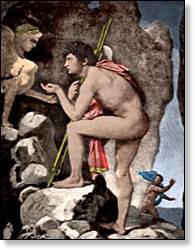

| |
| |
| Sphinx (sfinks). Monster with the head of a woman, the wings of a griffin and the body of a lion. The Sphinx stopped travelers on the road to Thebes and posed them a riddle. If they answered wrong, they died. The hero Oedipus was asked the following question: "What walks on four legs in the morning, two legs at noon and three at close of day?" Oedipus replied that a human crawls on four legs as an infant, walks upright on two in the prime of life and hobbles with a cane in old age. Hearing this, the Sphinx promptly ran off and killed herself. The grateful people of Thebes made Oedipus their king. | |
|
|

|

| "Oedipus and the Sphinx" by Ingres, from the Louvre, Paris. Black and white lithograph colored by Christopher Rifkind. |
| Sphinx (sfinks). Monster with the head of a woman, the wings of a griffin and the body of a lion. The Sphinx stopped travelers on the road to Thebes and posed them a riddle. If they answered wrong, they died. The hero Oedipus was asked the following question: "What walks on four legs in the morning, two legs at noon and three at close of day?" Oedipus replied that a human crawls on four legs as an infant, walks upright on two in the prime of life and hobbles with a cane in old age. Hearing this, the Sphinx promptly ran off and killed herself. The grateful people of Thebes made Oedipus their king. |